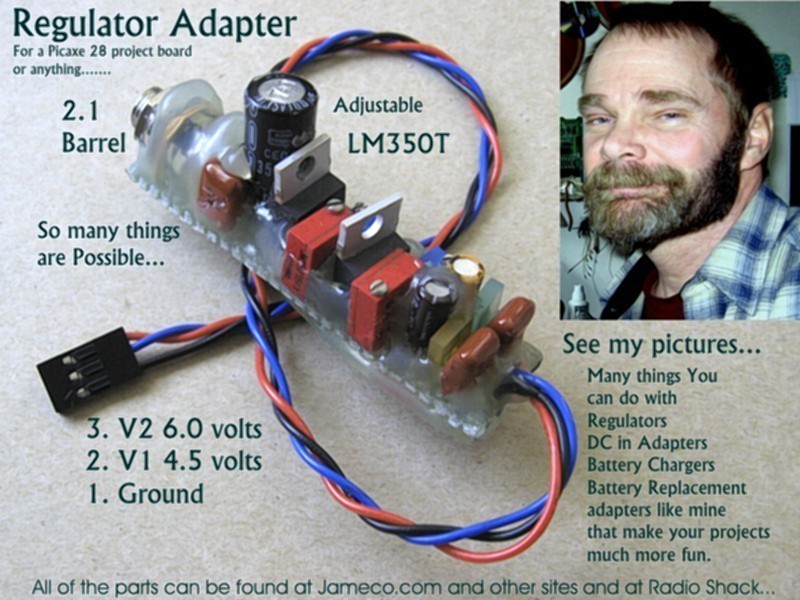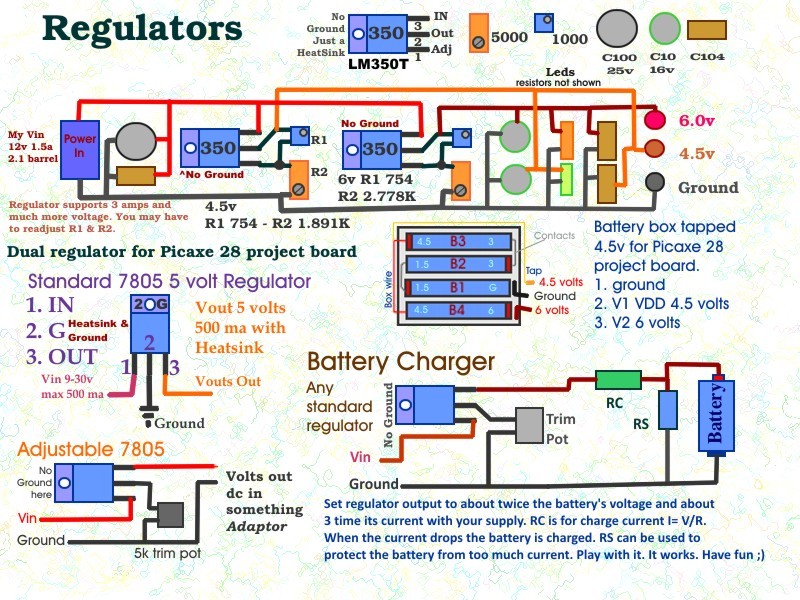Anyone that has played with these little workhorses of our world and wondered how they work, read on. The standard three-terminal regulators like the 7805 (5v) are what most people see and use without thinking too much about them. All voltage regulators work about the same. They read a reference voltage between Volts In and Ground and/or Volts Out and they use this reference to set the output voltage. When a load is applied, this reference keeps the output voltage steady.
You can play games with these old regulators by putting a resistor between the Ground Pin and Ground. This can make a standard 7805 give any voltage between 5 volts and your supply voltage. This shows how much regulators are the same.
About supply voltage to a regulator: You need to have at least the regulated voltage plus 2/3 more for basic operation of a regulator. That is, 5 plus about 4 equals about 9 volts, the minimum to get a steady regulated output from a 7805. You also need the current capability of your supply to equal at least twice as much current as your circuit needs. Why? Too little input current equals poor regulation. The regulator will lose its reference voltage.
A good starting point is about twice the voltage and the current that your circuit needs. So for a 5-volt regulator, a 12-volt, 1.5-amp supply is fine. Twelve volts is on the low side for good stable regulation, but having 1.5 amps available makes it a good power supply for a great many things. Each LED uses about 5-10 milliamps. Each servo uses about 20 milliamps. Each motor, 20 to 50 milliamps; and so on. (One amp is 1000 milliamps.)
A power LED is a great way to monitor your power supply. Use a standard-sized LED, in series with a 460Ω to 1000Ω (1kΩ) resistor, connected across power and ground. It will dim and flicker a little each time something like a servo or motor starts up, and that is normal. If the LED stays dim, then you may have something wrong. Not having enough power will do this. Regulators will just shut down or act funny if they do not have enough input voltage for stable operation.
Adjustable regulators look the same as any other regulator, but they are not the same. Read your documentation. They usually have no ground pin. The center pin (2) and the heatsink are not ground and should not be connected to ground. In the LM350T 3-amp regulator, only R2 connects to ground. In the circuit R1 connects to Volts Out and to pin 1 (Adjust) and R2 connects to pin 1 (Adjust) and to ground. You set your output voltage by adjusting R1 and R2 until you get about 1.25 volts across R1. Then R2 gives you the voltage range of your regulator with your supply. It can be fun getting this to work if your supply voltage and/or current are too low. Look at my R1 at 754Ω. R1’s range is affected by how big the difference is between your supply voltage and your regulated output voltage. See the pictures.
Regulators make great battery chargers. What is a battery charger? It is about 1.5 times your battery’s voltage with enough current to tell the battery you are charging it. Too little voltage or current and the battery will just think you are a load. A car battery is an example: you only need about 16 volts, but you need to supply about 10 or more amps to be a charger for it.
Higher voltages with low current are trickle chargers. Remote-controlled toys usually have a battery pack of two or more cells. Each cell is 1.2 volts. Just add them up and multiply them by 1.5 to get your starting supply voltage for charging. Use a power supply that provides two or three times the current of your battery pack and you have a charger for it.
Charging a battery requires monitoring the current going into the battery. When you first hook up your charger the current will be high. When the battery reaches a full charge the current will drop. Put a resistor of about 100 ohms between the charger’s “plus” lead and the battery’s “plus” terminal, measure the voltage across it and use Ohm’s law to get your charging current: I=V/R. You can use an analogue port of a microprocessor to control your battery charger. Many things are possible.
For the battery adapter for my Picaxe 28 project board I made the circuit diagram as simple as possible because the 350 regulator looks like any other regulator. Do not hook the heatsink (pin 2) to ground. Use a heatsink if you need to. You may need to readjust the pots if you use a higher supply voltage. The 350 is a 3-amp regulator so you can use a higher current supply too. These kinds of adapters make robots and things easier to play with. I left the pots in so that I could use my adapter for other things. All of the parts are available from Jameco.com and other sites and most at RadioShack.
Enjoy
Steve








